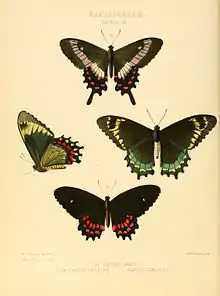Parides phalaecus
Parides phaleucas is a species of butterfly in the family Papilionidae. It was described by William Chapman Hewitson in 1869. It is found in Ecuador and Peru.
| Parides phalaecus | |
|---|---|
 | |
| Illustration accompanying the original description in Hewitson's Illustrations of New Species of Exotic Butterflies of 1869 | |
| Scientific classification | |
| Kingdom: | |
| Phylum: | |
| Class: | |
| Order: | |
| Family: | |
| Genus: | |
| Species: | P. phalaecus |
| Binomial name | |
| Parides phalaecus | |
| Synonyms | |
| |
Description
Parides phalaecus has a spatulate tail. The body is very hairy and the white band, which traverses both wings, is intersected by black veins. "A white band from costal margin of forewing to anal angle of hindwing, parallel to distal margin of forewing, shaded with black scaling on forewing and distally on hindwing, interrupted by the black veins; the band close to cell on both wings, wider in female than in male; female with white spot in cell of forewing; a row of red submarginal spots on hind wing, densely shaded with black on upperside, especially in male". [2] A full description is provided by Rothschild, W. and Jordan, K. (1906)[2]
Subspecies
There are two subspecies.
- P. p. phalaecus Ecuador
- P. p. nieva Möhn, 1999 in Butterflies of the World 8: 1, pl. 1, f. 1-4, type locality: Rio Nieva, 2500-3000 m, Amazonas, northern Peru.
Biology
The larva feeds on Aristolochia weberbaueri
Taxonomy
Parides phalaecus is a member of the ascanius species group[3] ("Fringe-spots white. Hindwing with submarginal spots and usually also discal spots or dots, or a discal band; mostly with tail".) A quadrate whitish spot in space 2 of the forewings is quite peculiar of the ascanius group.[4]
The members are
- Parides agavus (Drury, 1782)
- Parides alopius (Godman & Salvin, [1890])
- Parides ascanius (Cramer, [1775])
- Parides bunichus (Hübner, [1821])
- Parides gundlachianus (C. & R. Felder, 1864)
- Parides montezuma (Westwood, 1842)
- Parides phalaecus (Hewitson, 1869)
- Parides photinus (Doubleday, 1844)
- Parides proneus (Hübner, [1831])
References
- Hewitson (1869). "Descriptions of two new species of Papilio from Ecuador". Transactions of the Entomological Society of London. 1869 (1): 31-32.
- Rothschild, W. & Jordan, K. (1906). "A revision of the American Papilios". Novitates Zoologicae. 13: 411-752. (Facsimile edition ed. P.H. Arnaud, 1967)
 This article incorporates text from this source, which is in the public domain.
This article incorporates text from this source, which is in the public domain. - Edwin Möhn, 2007 Butterflies of the World, Part 26: Papilionidae XIII. Parides Verlag Goecke & Evers Verlag Goecke & Evers ISBN 9783937783277
- Racheli, Tommaso an Olmisani. Luca (1998). "A cladistic analysis of the genus Parides Hubner, [1819], based on androconial structures (Lepidoptera: Papilionidae)". PDF. Neue Entomologische Nachrichten. (Marktleuthen), 41:119-131.
| Wikimedia Commons has media related to Parides phalaecus. |
- Collins, N. Mark; Morris, Michael G. (1985). Threatened Swallowtail Butterflies of the World: The IUCN Red Data Book. Gland & Cambridge: IUCN. ISBN 978-2-88032-603-6 – via Biodiversity Heritage Library.
- Lewis, H.L. (1974). Butterflies of the World ISBN 0-245-52097-X Page 26, figure 19
- Möhn, Edwin (1999). Schmetterlinge der Erde Butterflies of the World Part VIII (8), Papilionidae V. New and rare Neotropical Papilionidae. Edited by Erich Bauer and Thomas Frankenbach Keltern: Goecke & Evers; Canterbury: Hillside Books. ISBN 978-3-931374-75-4
- Möhn, Edwin (2006). Schmetterlinge der Erde. Butterflies of the World Part XXVI (26), Papilionidae XIII. Parides. Edited by Erich Bauer and Thomas Frankenbach Keltern: Goecke & Evers; Canterbury: Hillside Books. ISBN 978-3-937783-27-7 (Supplement 13 in English - by Racheli)